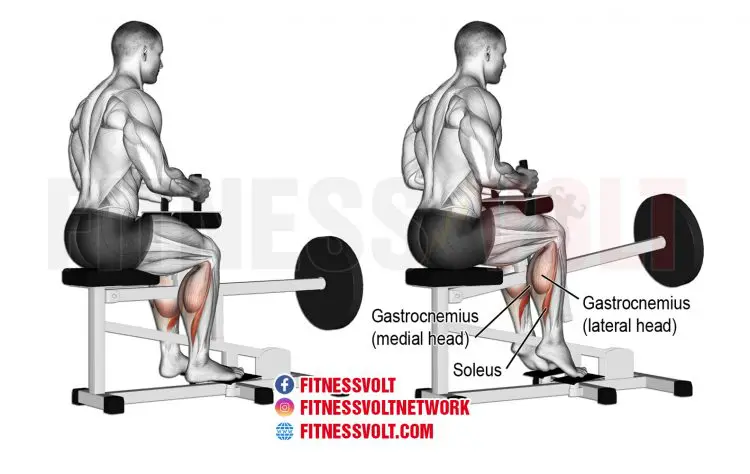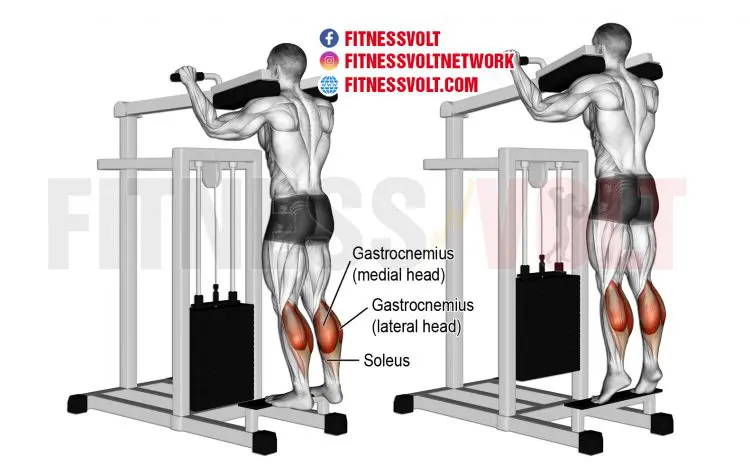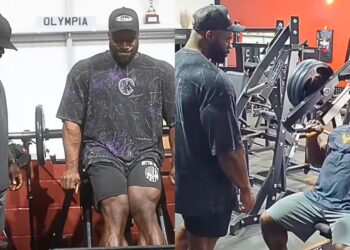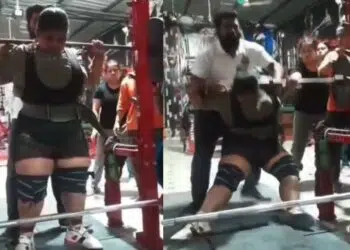The barbell seated calf raise is underutilized, but that doesn’t mean it’s ineffective. It may take a backseat to fancy machines but it can still develop your calves just the same.
It’s a great variation of the calf raise if you have limited equipment (e.g. a home setup). But you can still utilize it as a gym exercise as well. So, before you write this variation off completely, consider some of its advantages which we’ve provide below.
Here’s a guide to the barbell seated calf raise…
Muscle Worked
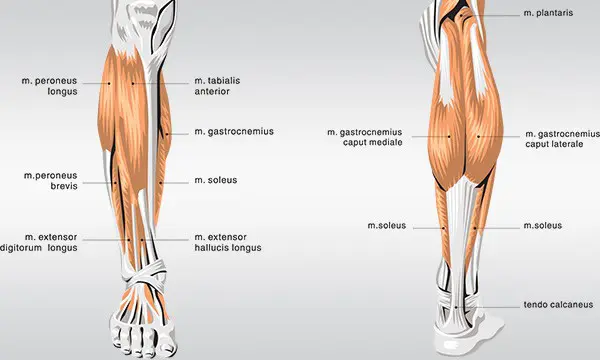
Gastrocnemius
The gastocnemius is the largest and most visible calf muscle that flexes when we walk. It’s a two-headed muscle (lateral and medial head) that starts from just above the knee and extends all the way down to the ankle forming the achilles tendon with the smaller soleus. Gastrocnemius points the toes down and crosses the knee joint and can therefore also flex the knee.
Soleus
Soleus hides behind the gastrocnemius starting from the knee and extending to form the achilles tendon with the larger gastrocnemius. It plantarflexes the foot and is capable of exerting lots of force at the ankle. Consequently, seated calf raises are believed to be the best exercise for the soleus.
Level Up Your Fitness: Join our 💪 strong community in Fitness Volt Newsletter. Get daily inspiration, expert-backed workouts, nutrition tips, the latest in strength sports, and the support you need to reach your goals. Subscribe for free!
Plantaris
The plantaris is a small, superficial muscle of the lower leg that extends a few inches down from the knee, located between the gastrocnemius and soleus. It’s a weaker plantar flexor and knee flexor.
How To Do The Barbell Seated Calf Raise
The barbell seated calf raise is a little more complicated than other variations that are better designed to allow you to be able to perform this exercise more conveniently, comfortably, and even more effectively. However, this variation offers an option to train your calves when these other means of training aren’t so readily available.
With that being said, you’ll need either a fixed barbell or an adjustable barbell that you can comfortably maneuver around. Also, you should ideally have either a block, a couple weight plates, or a slightly elevated object that you can place the top of your feet on so that your heels are free to move up and down. If you don’t, then it’s not absolutely needed as you can do calf raises on flat ground.
Something with cushion to place on your thighs or wrap around the bar can also be useful.
Here are step-by-step instructions for the barbell seated calf raise.
- Sit on the end of a bench, chair, or anything similar and place the barbell on the end of your thighs near your knee but not on your knee, of course.
- Sit up straight and place the top half of your feet or balls of your feet on the elevated object so that your heels are hanging off.
- Lower your heels just until you feel a decent stretch in your calves, and then flex your calf muscle to lift your heels as high as you can. Squeeze and hold for a second.
- Lower your heels back down and repeat.
Here’s a video example…
Exercise Tips
- Have a firm grip on the barbell to keep in it one place to ensure consistent resistance on the calves.
- The bar should be closer to the knees so that most of the weight on the calves.
- Avoid rocking backward, although, you can lean slightly forward.
- Perform the reps nice and slow using a full range of motion.
- Never do these heavy without a progressive warm up. You can cause strain on your ankles and tendons.
Related: The 11 Most Effective Calf Raise Exercises
3 Seated Calf Raise Variations
While the barbell variation is a great option, it’s not usually the most practical. Not to mention, you can get a lot more out of the calf raise movement using machines designed for this specific exercise.
Here are three of the best calf raise variations…
Machine seated calf raise
Alright, now we’re talkin…
The machine seated calf raise is one of the best exercises for training the calves because it’s simple to use, comfortable, and you can load it up with a lot of weight. Because it’s made specifically for the calf raise, you’ll likely enjoy this variation a lot more than having to carry around and balance on your legs.
Not to mention, you’re much more limited in the amount of weight that you can comfortably use with the free weight barbell variation.
But you still need to do progressive warm up sets with the machine seated calf raise and you probably don’t want to go too crazy with the weights either.
Level Up Your Fitness: Join our 💪 strong community in Fitness Volt Newsletter. Get daily inspiration, expert-backed workouts, nutrition tips, the latest in strength sports, and the support you need to reach your goals. Subscribe for free!
Note: You can also use a Smith machine for this exercise, although, it still won’t be as convenient as the dedicated calf raise machine.
Dumbbell seated calf raise
Remember, you can do any exercise using dumbbells that you can with a barbell. And the seated calf raise using dumbbells is actually many times preferred over using a barbell because it’s much more practical. Dumbbells take up less space, they’re more comfortable to sit on your thighs, you can change them out much quicker and easier, you can easier train one leg at a time, and you get the point.
There are may advantages to using dumbbells.
Standing calf raise
While this isn’t a seated variation, it’s still a must-have variation for training calves.
Now you can either do this variation using a dedicated machine such as the standing calf raise machine, or, you can do it free standing while holding a dumbbell. There’s also a third option which is to use just your own body weight which is totally effective too.
The standing variation is great because it’s also more comfortable but it’s much easier to adjust the weight which usually just involves taking out and inserting a pin. This makes it even more convenient than the machine seated calf raise.
Also, because you have the support of lower body, upper body and core muscles, you can effectively lift maximal loads and even use cheat reps to overload your calves.
How To Incorporate The Barbell Seated Calf Raise Into Your Training Regime
The barbell seated calf raise can be incorporated into your routine in many different ways. But where it really comes in handy is if all you have access to is a barbell (home training or limited equipment) or the calf training equipment at your gym is being held up.
We’re not saying it’s useless otherwise because that’s simply not true. But because it typically requires more setup, machines or a free standing variation is often preferred. However, there is a time and place for having alternatives, unless, of course, you normally include the barbell seated calf raise in your training, which is great too.
But here are a few useful ways to include this exercise in your training.
As a finisher
There are two reasons why this exercise makes a great finisher. The first being that we don’t recommend using heavy weights with the barbell calf raise, and the second being that high-rep burnouts are great to include in your calf training.
So, at the end of your training, grab a light to moderate barbell and just pump out reps until your calves are totally fatigued.
In a superset
While the barbell seated calf raise does typically require more setup at first, it’s still a great option for a superset which involves doing two different exercises back to back with little to no rest in between.
Because once you’re set up, everything else is easier especially if you stick with one weight and don’t have to add or subtract any weight plates. So, we recommend sticking with one weight to make the process as quick and easy as possible.
It doesn’t matter what exercise you pair it with either, although, a standing calf raise variation could be a great movement to pair it with because you can maximize the benefits of both the seated and standing calf raise. But it’s totally up to you.
Wrapping Up
The barbell seated calf raise is a viable option for training your calf muscles. Whether you train at home or at a fitness center, it’s an option that may require a little more preparation, but if you’re limited otherwise, it’s not a bad choice.
Interested in measuring your progress? Check out our strength standards for Barbell Calf Raise, Seated Calf Raise.

